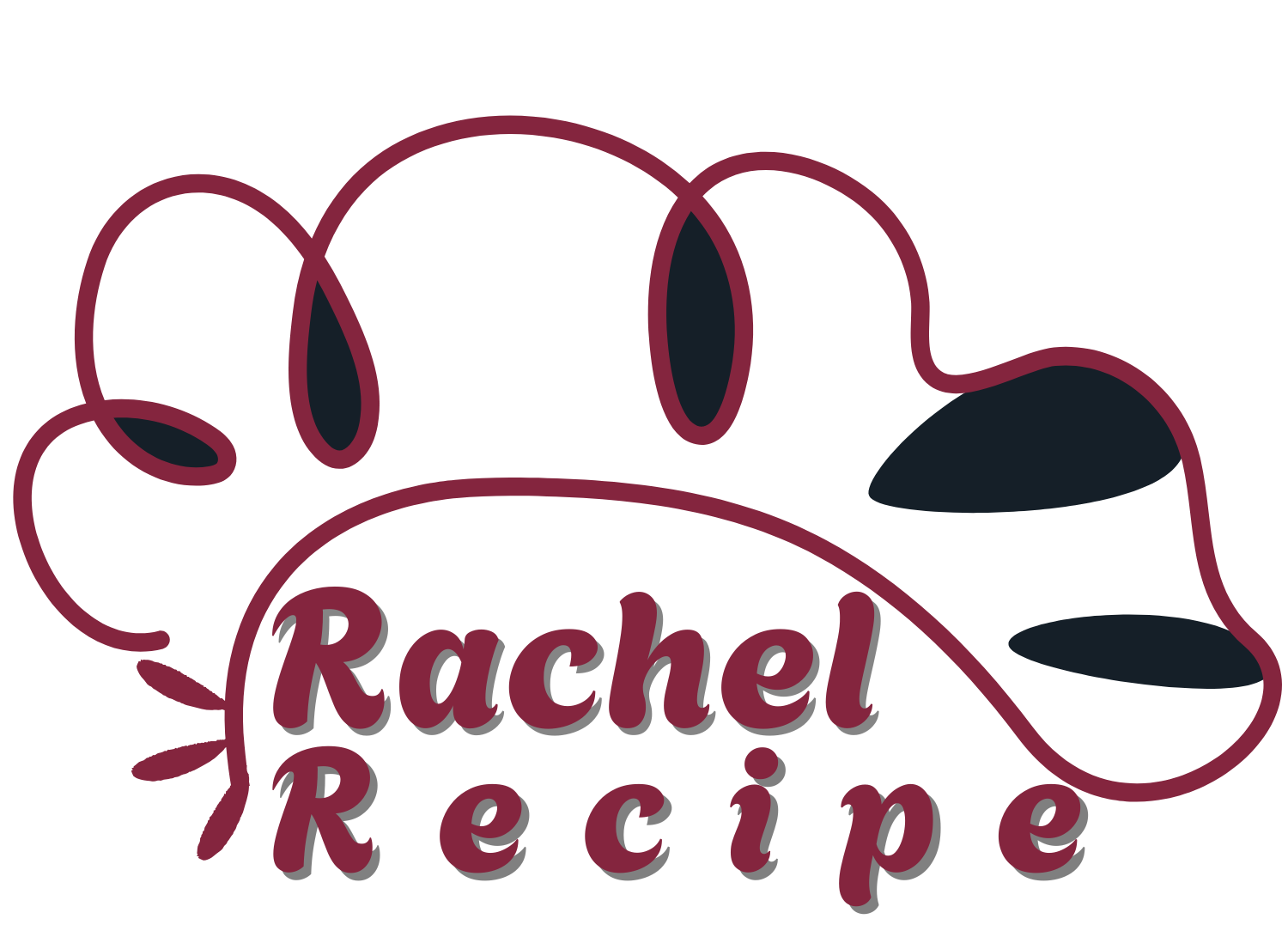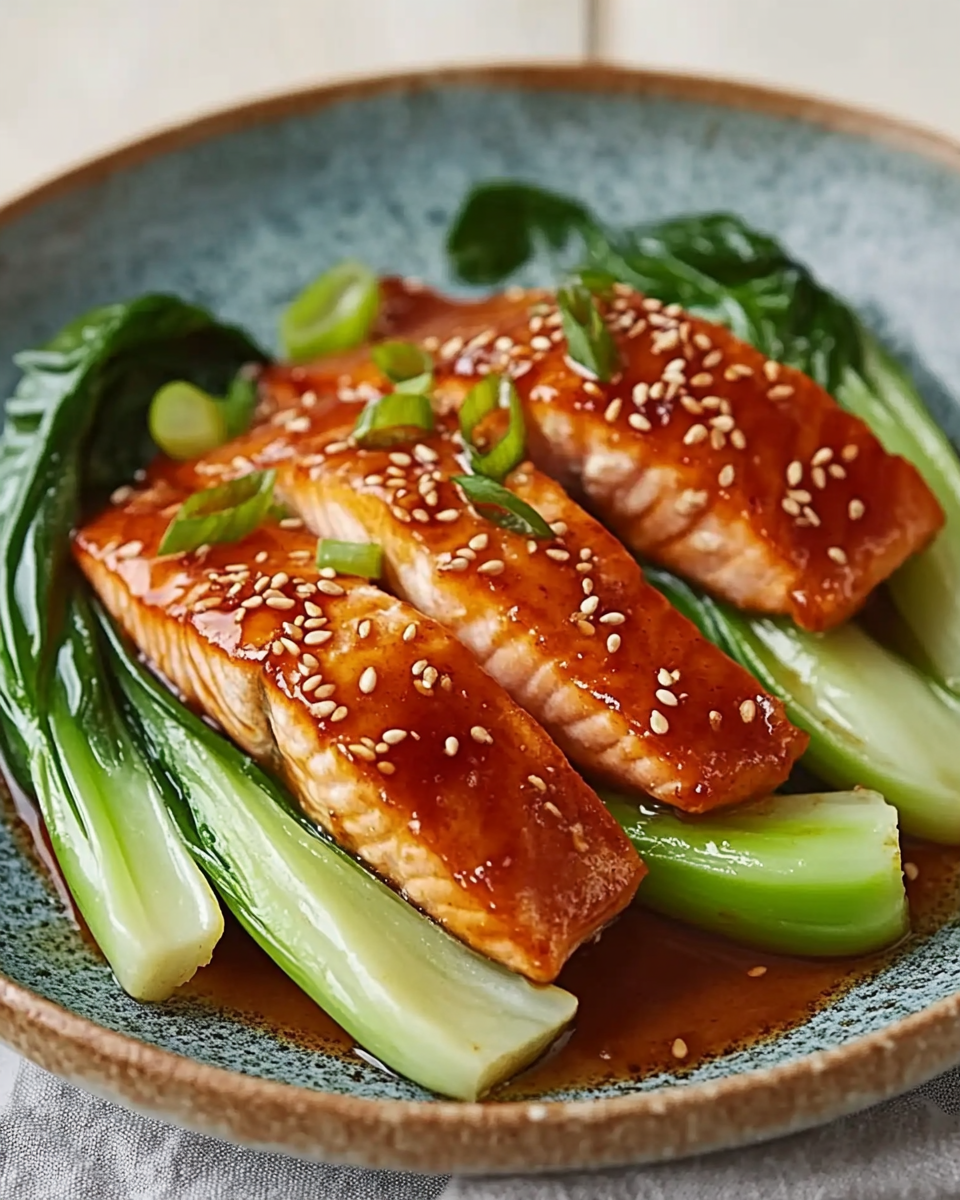The allure of this Teriyaki Salmon lies in its perfect balance of flavors—sweet from the honey and chilli sauce, salty from the soy, and a warming depth from the ginger and sesame oil. Paired with crunchy, stir-fried pak choi, this dish offers a delightful contrast of textures and tastes in every bite.
Not only is it packed with omega-3s and micronutrients, but it’s also an excellent go-to for busy weeknights. With a prep time of just 10 minutes and a hands-off bake, it’s a stress-free path to a beautiful, healthy dinner that looks like it came from a restaurant kitchen. Serve with rice or noodles for a more filling experience or enjoy it on its own as a light, nourishing meal.
Full Recipe:
-
2 salmon fillets (skinless)
-
2 tbsp sweet chilli sauce
-
1 tbsp honey
-
1 tsp sesame oil (plus 1 tsp for stir-frying)
-
1 tbsp mirin or dry sherry
-
2 tbsp soy sauce
-
1-inch piece fresh ginger, finely grated
-
2 pak choi heads
-
1 tbsp vegetable oil
-
2 garlic cloves, grated
-
100ml vegetable stock
-
1 tbsp toasted sesame seeds
-
Brown rice or noodles, to serve (optional)
Directions:
-
Preheat the oven to 200°C (180°C fan)/Gas 6. Place the salmon fillets in a shallow baking dish.
-
In a small bowl, mix the sweet chilli sauce, honey, sesame oil, mirin (or sherry), soy sauce, and grated ginger. Pour over the salmon, ensuring they’re well coated.
-
Bake the salmon for 10 minutes until cooked through and glazed.
-
Meanwhile, slice across the base of the pak choi to separate the leaves.
-
Heat the vegetable oil and 1 tsp sesame oil in a wok or large frying pan. Add the grated garlic and stir-fry briefly until softened.
-
Add the pak choi and stir-fry until the leaves begin to wilt. Pour in the vegetable stock, cover tightly, and cook for 5 minutes until the stems are tender but still crisp.
-
Serve the pak choi in shallow bowls, top with the baked salmon, spoon over the teriyaki juices, and scatter with toasted sesame seeds. Serve with rice or noodles, if desired.
Prep Time: 10 minutes | Cooking Time: 15 minutes | Total Time: 25 minutes
Kcal: ~400 kcal | Servings: 2 servings
The Harmony of Flavors: Teriyaki Salmon with Sesame Pak Choi
In the vibrant world of fusion cuisine, few dishes manage to strike a perfect chord between simplicity, nutrition, and flavor quite like Teriyaki Salmon with Sesame Pak Choi. This dish, rooted in Japanese culinary tradition but infused with global accessibility, is a shining example of how minimal ingredients can produce complex, balanced results. It’s an ideal meal for anyone seeking a quick, health-conscious dinner without compromising on taste or presentation.
Why Teriyaki Salmon Is a Modern Classic
Teriyaki salmon has become a global staple for good reason. Its hallmark is the beautiful glaze formed by the teriyaki sauce—a mixture traditionally composed of soy sauce, mirin, sugar, and sake. In modern kitchens, this profile has expanded to include accessible ingredients such as honey, sweet chili sauce, and even dry sherry as substitutes for mirin. The result is a thick, shiny, slightly sticky coating that enhances the natural richness of the salmon without overpowering it.
Salmon itself is a superstar ingredient—rich in omega-3 fatty acids, protein, and essential vitamins like B12 and D. Its buttery texture and robust flavor are well complemented by the umami sweetness of teriyaki. When cooked correctly, salmon turns tender and flaky, absorbing the sauce while retaining its structural integrity and vibrant color.
The Supporting Role of Sesame Pak Choi
Every great main needs a co-star, and pak choi (also known as bok choy) is the ideal companion to teriyaki-glazed salmon. This leafy green from the brassica family brings freshness, crunch, and a slightly peppery note that balances the richness of the fish. It’s often overlooked in Western kitchens but is a staple in East and Southeast Asian cuisines due to its versatility, nutritional value, and quick cook time.
In this dish, the pak choi is sautéed with garlic in a combination of vegetable and sesame oil, adding nuttiness and depth. A splash of vegetable stock is used to steam the stems, making them tender while keeping the leaves bright and slightly crisp. Toasted sesame seeds are scattered on top just before serving, providing a subtle crunch and reinforcing the sesame theme. This simple technique results in a vegetable side that feels refined and full of flavor.
The Nutritional Value of This Dish
One of the reasons this meal is ideal for modern eaters is its well-rounded nutritional profile. It’s high in protein, thanks to the salmon, and rich in essential fatty acids, which are known for their heart-protective and anti-inflammatory properties. The pak choi contributes valuable micronutrients, including vitamins A, C, and K, as well as calcium and folate.
Furthermore, the ingredients used to create the teriyaki glaze—though sweet—are used in moderation, especially when compared to heavy cream sauces or fried preparations. You can make this dish even lighter by serving it without rice or noodles, or go for brown rice or soba noodles to keep it balanced and fiber-rich.
For those on a gluten-free diet, this dish can be easily adapted with gluten-free soy sauce (or tamari), and the rest of the components are naturally gluten-free. It’s also dairy-free and can be adjusted to low-carb plans depending on your side dish choices.
Quick and Convenient for Busy Schedules
Another reason for the popularity of teriyaki salmon with sesame pak choi is its suitability for weekday cooking. From start to finish, the dish takes around 25 minutes, making it a great choice for professionals, parents, or students who want a gourmet-level dish without investing hours in the kitchen.
Because the salmon is baked in a single dish with the sauce, there’s minimal cleanup involved. While it cooks, you can quickly prepare the pak choi on the stovetop. This workflow ensures efficiency without sacrificing quality or flavor.
Additionally, this recipe is scalable. Whether you’re cooking for two or preparing a meal for a larger group, you can easily adjust the quantities without needing complex recalculations. It’s also a great dish to meal prep, as both components store well in the refrigerator and reheat nicely.
Teriyaki Origins and Global Evolution
The term “teriyaki” comes from the Japanese words “teri” (shine) and “yaki” (grill or broil). It originally referred to a method of cooking in which meat or fish was glazed with a sweetened soy sauce and then grilled or broiled to achieve a glossy finish. While the traditional version is cooked over an open flame or under a broiler, modern teriyaki adaptations like this one opt for oven-baking, which allows the sauce to thicken and caramelize beautifully around the fish.
Over the years, teriyaki has evolved and been embraced by various culinary cultures, including Hawaiian cuisine (where it’s often combined with pineapple) and American cooking (where it’s frequently used as a marinade or barbecue glaze). The version presented in this recipe reflects a European interpretation, incorporating sweet chili sauce and accessible pantry items like honey and sherry.
Flavor Profiles and Texture Experience
This dish is all about balance. The sweet and salty notes of the teriyaki glaze harmonize with the richness of the salmon, while the ginger and garlic add heat and aromatics. The sesame oil brings an earthy nuttiness that enhances the greens without overwhelming them. The pak choi, once steamed, remains slightly crisp at the base with silky-soft leaves—creating a pleasing mouthfeel that contrasts the flakiness of the fish.
A final touch of toasted sesame seeds not only enhances the visual appeal but also adds a subtle crunch and aroma that completes the experience. Served in shallow bowls, perhaps with a scoop of brown rice or soba noodles, this dish feels satisfying, complete, and well-curated.
Presentation Tips for an Elegant Meal
When plating this dish, consider placing the wilted pak choi at the base of the bowl or plate to form a bed. Gently place the salmon on top, allowing the glaze to cascade slightly down the sides. Spoon some of the remaining teriyaki sauce over the top for shine, and sprinkle the sesame seeds as the final garnish.
For an extra pop of color and flavor, consider adding thin slices of red chili or a few strands of finely sliced scallions on top. A wedge of lime or a drizzle of citrus juice can also help cut through the sweetness of the glaze and add a refreshing note.
If you’re hosting guests, pairing this meal with a crisp white wine like Sauvignon Blanc or a light Japanese beer can elevate the dining experience.
Variations and Customizations
This recipe is versatile and welcomes customization. If salmon isn’t your preference, try substituting it with tofu for a vegetarian version, or with chicken thighs for a meatier alternative. The teriyaki glaze works equally well with a variety of proteins, provided the cooking times are adjusted accordingly.
You can also experiment with the vegetable pairing—try baby spinach, kale, or even broccoli in place of pak choi. Each will offer a slightly different texture and nutrient profile while still absorbing the flavors of the sesame oil and garlic.
Adding a sprinkle of chili flakes or using a chili-infused sesame oil can turn up the heat, while incorporating fresh herbs like cilantro or Thai basil can lend a more aromatic, herbaceous finish.
Conclusion: A Dish That Ticks All the Boxes
Teriyaki Salmon with Sesame Pak Choi is a dish that proves simplicity doesn’t have to mean blandness. In just a few steps and with a handful of pantry staples, you can create a meal that is visually stunning, nutritionally sound, and gastronomically satisfying. It’s a perfect marriage of East and West—a dish that can be dressed up for entertaining or pared down for a quick solo dinner.
Whether you’re exploring healthier eating habits, expanding your global culinary repertoire, or simply craving something deeply delicious, this dish delivers on every front. It’s light yet indulgent, complex yet easy to make, and endlessly adaptable to your preferences. Teriyaki salmon is no longer just a restaurant favorite—it’s a staple you can confidently master at home.






